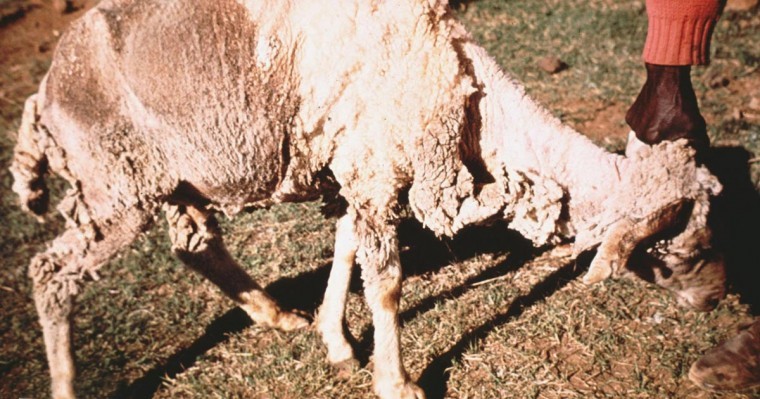Lesley Stubbings of SCOPS says the risk from scab is huge and at a ‘tipping point’ with the increase in movements seen during the autumn and winter adding more risk to the year-round problem.
Sheep scab is caused by an infection with the mite Psoroptes ovis, but it can take weeks or even months before clinical signs are obvious, so farmers cannot tell just by looking at a sheep whether it is infected or not.
Ms Stubbings said: “If you are buying in sheep or they have come into contact with sheep of an unknown scab status then you must assume they have it.”
Sheep scab is endemic within the UK with figures suggesting between 7-10,0001 clinical cases a year at an estimated cost of £12-182 a ewe. However, Ms Stubbings believes the figure is a lot higher as she has seen more cases in the last 12 months than ever.
“This is the worst year that I have known. Our local mobile sheep dipper is run off his feet. Part of this could be that endemically infected flocks may not have clinical signs and they do not realise that scab is still active in their sheep so they are not controlling it. It could also be associated with resistance to some injectables,” she said.
Prevention
Dr Peter Bates from Veterinary Medical Entomology Consultancy (VMEC), says most scab is controlled at farm level, mostly on a reactive basis, once the parasite has taken hold in the flock. However, he warns that this firefighting approach can be expensive and can result in the overuse/misuse of the few treatments available.
“The use of diazinon plunge dip formulations via non-validated methods of application such as showers has the potential to generate resistance in scab mites. The overuse of macrocyclic lactone (ML) injections for scab control can generate resistant gut worms, increasing the problem of anthelmintic resistance. There are also the negative economic effects of unplanned scab treatments, particularly the excessive meat withdrawal periods (MWPs) on the marketing of finished lamb,” he said.
Instead, he suggests scab control at farm level needs to be more pro-active and strategic in order to be cost effective.
“For effective in-flock eradication, all sheep on/off the main holding should be treated at a convenient/cost-effective time. Winter is ideal, with the lowest number of sheep (less treatment used), more tolerable MWPs and a full fleece is ideal for plunge dipping. Once eradicated, a plan must be formulated to keep scab out and this plan must be included in a Flock Health and Welfare Plan,” he said.
For farmers buying in sheep there are 3 things to prevent scab from entering your flock:
- Always assume the sheep have scab
- Keep animals in quarantine (isolated) for at least 3-4 weeks
- Treat or test the quarantined animals. This can involve:
- Blood test all the animals in quarantine after two weeks to see whether they have been in contact with sheep scab. This is the ideal first step as it can avoid unnecessary treatment.
- Injection with Macrocyclic Lactones (ML)
- Plunge dip using an organophosphate (OP) (diazinon) dip.
Treatment options
Dr Dave Armstrong from Zoetis says correct plunge dipping is one of the best ways to remove scab, but says for those farmers unable to dip due to inadequate facilities or the cost, then using the correct injectable and only when necessary is important.
“It’s vital to remember all ML’s are also wormers so ensure their use is necessary at this time of the year and avoid repeat doses”.
“Most ML’s don’t offer persistent protection against scab. That means after treatment with a non-persistent ML sheep need to be moved to pasture that hasn’t contained sheep for three weeks, as the scab mites can live in the environment for 17 days,” he said.
Dr Armstrong added: “Where this isn’t possible, using either CYDECTIN® 1% or CYDECTIN 2% is an option as both offer persistent protection for 28 days and 60 days respectively, meaning sheep are protected regardless of whether sheep are moved to previously grazed fields or not. However, all treatments should be discussed with your medicines provider.”
Professor Richard Wall from Bristol University who was involved in the study that identified ML resistant scab mites, says despite a number of recent education campaigns, little apparent progress has been made towards identifying the best approach to scab management or implementation. Despite this he urges farmers to be vigilant and proactive.
“The appropriate management of scab is essential on both welfare and economic grounds,” he said.
Pictured: Severe case of sheep scab caused by Psoroptes mites, by Alan R Walker (CC BY-SA 3.0).




